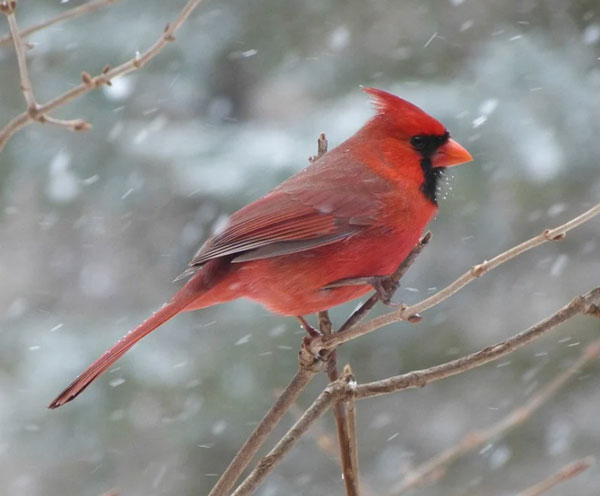We have quite a few species of birds that over-winter in Ohio. Once the snow starts flying, their food and unfrozen water sources can become hard to find. Even if you only have a small backyard patio area, you can still provide for the birds this winter.
There are several ways to provide food for our feathered friends. There are five basic types of feeders, each attracting certain species. Ground feeding tables attract doves, juncos, sparrows, towhees, goldfinches, and cardinals. By using a table instead of just scattering the feed on the ground it keeps some of the droppings separated from the feed. A basic hopper feeder, in which the feed flows out the bottom as it is eaten, will attract jays, grackles, cardinals, and red-winged black birds. The tube thistle feeder is popular with all finches. Suet feeders not only attract titmice, woodpeckers, chickadees, and nuthatches, but often times the unwanted starling, also. To deter starlings, limit the access to the suet holder. Smaller birds can hang upside down to eat from it while the starlings cannot. If you only put out one type of feeder, a sunflower feeding tube should be the feeder of choice. The sunflower seeds attract the smaller birds, but the larger birds will eat also.
To maximize the number of species at your feeder, you will want to offer a variety of food. Black-oil sunflower seed attracts cardinals, woodpeckers, blue jays, gold finches, purple finches, chickadees, titmice, and nuthatches. Goldfinches love Niger seed. The sparrows, juncos, and doves favor white millet. If you would like to see woodpeckers, nuthatches, and chickadees, make sure to hang a suet cake. Corn, either on the ear, shelled, or cracked, will attract blue jays, sparrows and starlings.
Once you have your feeders up and filled, be patient. It may take several weeks for the birds to find your feeder. Keep the feeders full and clean. Shake tube feeders to dislodge any wet compacted feed and empty the wet feed before refilling. Clean off trays and platforms. At least once a winter clean the feeders in a solution of two ounces of bleach to two gallons of water. Rinse and let dry before refilling.
Birds still need water, even in the winter, so you might consider installing a birdbath. There are models available that will keep the water from freezing, or there are small water heaters made that can be placed in a bird bath.
It can be a neat hobby to feed the birds and then determine exactly which species are coming in to your feeder. Have fun identifying the birds as they flock to your feeder and water source!
Our annual berry plant sale is going on now through April, 26th. | Order Online Today! • Our annual fish sale is going on now through April, 26th. Pickup day is May 7th. | Order Online Today! • We will be on Live At Noon on Tuesday, April 23, 2024 with Melissa.
